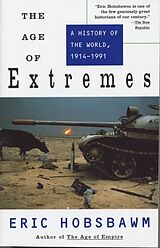Age of Extremes
Einband:
Broschiert
EAN:
9780679730057
Untertitel:
A History of the World, 1914-1991
Genre:
Geschichte
Autor:
Eric Hobsbawn
Herausgeber:
Vintage Books N.Y.
Auflage:
Vintage Books.
Anzahl Seiten:
672
Erscheinungsdatum:
13.02.1996
ISBN:
0679730052
Zusatztext "Penetrating. . . . Offers a powerful interpretation of the wellsprings of an age of unprecedently economic transformation! mass slaughter and social upheaval. . . . Facts roll off Hobsbawm's pages like thunderbolts." The New Republic "A magical re-creation of the most creative and destructive! the most utopian and most doubt-ridden period of human history. . . . I know of no other account that sheds as much light on what is now behind us! and thereby casts so much illumination on our possible futures." Robert Heilbroner "Powerful. . . . A bracing and magisterial work." The New York Times Book Review Informationen zum Autor Born in 1917, Eric Hobsbawm was educated in Austria, Germany, and England. He was Emeritus Professor of history at Birbeck College, University of London, and Emeritus Universtiy Professor of politics and socity at the New School for Social Research. He is the author of more than fourteen books, including The Age of Capital , The Age of Revolution , The Age of Empire , and The Jazz Scene . He died in 2012. Klappentext Dividing the century into the Age of Catastrophe, 1914-1950, the Golden Age, 1950-1973, and the Landslide, 1973-1991, Hobsbawm marshals a vast array of data into a volume of unparalleled inclusiveness, vibrancy, and insight, a work that ranks with his classics The Age of Empire and The Age of Revolution. In the short century between 1914 and 1991, the world has been convulsed by two global wars that swept away millions of lives and entire systems of government. Communism became a messianic faith and then collapsed ignominiously. Peasants became city dwellers, housewives became workers-and, increasingly leaders. Populations became literate even as new technologies threatened to make print obsolete. And the driving forces of history swung from Europe to its former colonies. Includes 32 pages of photos. Zusammenfassung Dividing the century into the Age of Catastrophe, 19141950, the Golden Age, 19501973, and the Landslide, 19731991, Hobsbawm marshals a vast array of data into a volume of unparalleled inclusiveness, vibrancy, and insight, a work that ranks with his classics The Age of Empire and The Age of Revolution . In the short century between 1914 and 1991, the world has been convulsed by two global wars that swept away millions of lives and entire systems of government. Communism became a messianic faith and then collapsed ignominiously. Peasants became city dwellers, housewives became workersand, increasingly leaders. Populations became literate even as new technologies threatened to make print obsolete. And the driving forces of history swung from Europe to its former colonies. Includes 32 pages of photos....
Autorentext
Born in 1917, Eric Hobsbawm was educated in Austria, Germany, and England. He was Emeritus Professor of history at Birbeck College, University of London, and Emeritus Universtiy Professor of politics and socity at the New School for Social Research. He is the author of more than fourteen books, including The Age of Capital, The Age of Revolution, The Age of Empire, and The Jazz Scene. He died in 2012.
Klappentext
Dividing the century into the Age of Catastrophe, 1914-1950, the Golden Age, 1950-1973, and the Landslide, 1973-1991, Hobsbawm marshals a vast array of data into a volume of unparalleled inclusiveness, vibrancy, and insight, a work that ranks with his classics The Age of Empire and The Age of Revolution.
In the short century between 1914 and 1991, the world has been convulsed by two global wars that swept away millions of lives and entire systems of government. Communism became a messianic faith and then collapsed ignominiously. Peasants became city dwellers, housewives became workers-and, increasingly leaders. Populations became literate even as new technologies threatened to make print obsolete. And the driving forces of history swung from Europe to its former colonies.
Includes 32 pages of photos.
Zusammenfassung
Dividing the century into the Age of Catastrophe, 1914–1950, the Golden Age, 1950–1973, and the Landslide, 1973–1991, Hobsbawm marshals a vast array of data into a volume of unparalleled inclusiveness, vibrancy, and insight, a work that ranks with his classics The Age of Empire and The Age of Revolution.
In the short century between 1914 and 1991, the world has been convulsed by two global wars that swept away millions of lives and entire systems of government. Communism became a messianic faith and then collapsed ignominiously. Peasants became city dwellers, housewives became workers—and, increasingly leaders. Populations became literate even as new technologies threatened to make print obsolete. And the driving forces of history swung from Europe to its former colonies.
Includes 32 pages of photos.

Leider konnten wir für diesen Artikel keine Preise ermitteln ...
billigbuch.ch sucht jetzt für Sie die besten Angebote ...
Die aktuellen Verkaufspreise von 6 Onlineshops werden in Realtime abgefragt.
Sie können das gewünschte Produkt anschliessend direkt beim Anbieter Ihrer Wahl bestellen.
Loading...
Die aktuellen Verkaufspreise von 6 Onlineshops werden in Realtime abgefragt.
Sie können das gewünschte Produkt anschliessend direkt beim Anbieter Ihrer Wahl bestellen.
| # | Onlineshop | Preis CHF | Versand CHF | Total CHF | ||
|---|---|---|---|---|---|---|
| 1 | Seller | 0.00 | 0.00 | 0.00 |
